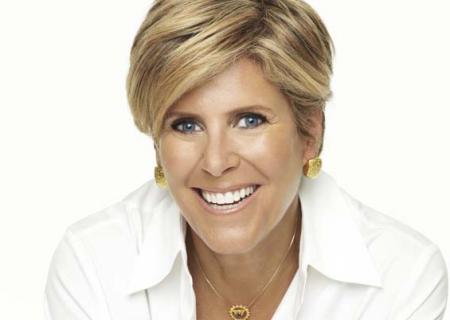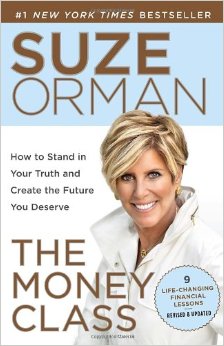By Guest Blogger Suze Orman

Spring is in the air! Springtime is about renewal and rebirth, and therefore a perfect to take stock of your life, and take charge of your finances. It’s time to get off the fence and spring clean your finances, ladies!
1. No Blame, No Shame
The foundation of a financial fresh start actually has nothing to do with money or specific financial dos and don’ts. The first, and most difficult, step is to absolve yourself and your spouse or partner of any guilt. So you need to make a promise to me. I need you to agree that the past is past, and we are going to focus on the future. Whatever mistakes you feel you have made with money, whatever moves you wish you had or hadn’t made, are irrelevant. We are free to move forward only when we remove the emotional shackles of regret. This cleansing step is especially important for couples. You are in this together, so no finger-pointing or arguing about any past decisions. Do we have a deal? Deep breath, everyone. Exhale. Now you are ready to put your financial house in order.
2. Take a Snapshot of Your Finances
It’s impossible to map out a route to your destination if you don’t know where you’re starting from. So let’s take a “before” picture of your finances. You’ve heard me say this a million times, but I want you to open every single financial statement—bank, credit card, mortgage, 401(k), brokerage account—and take a look. Only when you have everything in front of you can you set priorities about what to do next. If you’re vexed by your checking account (you swear you should have more money; you can never figure out why your checks bounce), start fresh by opening a new one. Leave enough in your existing account to cover any checks that haven’t yet been processed, then transfer the rest to the new account and close the old one. Next, sign up for online banking. It should be free, and as long as you use your home computer, it’s also safe. The advantage of online banking is that you can pay bills superfast, and your account is automatically credited or debited for each deposit and payment, making it easier to stay on track.
3. Adopt a Foolproof Credit Card Strategy
Make this the year you tackle that credit card debt once and for all. Doing so will make you and your family stronger and happier—forever. What happens to the stock market and the housing market is completely beyond your control. Credit card debt, however, is completely within your control. Every time you pay off a card with a 15 percent interest rate, you get a 15 percent return on your money.
See if you can qualify for a balance transfer card that offers a low or 0 percent introductory interest rate for the first six to 12 months. If you can get a good deal, move your high-rate debt to that new card. Do not use the card for any new charges, and push yourself hard to pay off the balance as soon as possible. If you don’t qualify, no worries. Always pay the minimum due on each card, on time, every month. Whenever possible, send in some extra money on the card that charges the highest interest rate. Your goal is to get the costliest balance paid off first. When the first card is cleared, direct your payments to the card with the next highest interest rate. Keep doing this until you’ve zeroed out the balances on all your cards.
4. Try Harder to Save
When I suggest that people send in more money to pay off credit card balances or increase the amount they save each month for retirement, I hear the same sad story: “Oh, Suze, I would if I could, but I can’t because there’s no extra money left at the end of the month.” I beg to differ. There’s no money left because you haven’t evaluated your spending habits. You need to dig deep and be willing to change those habits; to set goals and use those goals as the motivation for lifestyle changes that will allow you to save and invest. Take a clear-eyed look at your credit card statements for the past six months. Can you really tell me that there isn’t at least $50 or $100 showing up that you could easily do without? I didn’t think so. I call this “hidden money,” and here’s how you can find it.
I challenge you to reduce every one of your monthly utility bills by 10 percent. Change your calling plan or get rid of the landline account unless you absolutely need it. I bet you can seriously trim your utilities by spending one afternoon increasing your home’s energy efficiency: Attach a draft-blocking guard to the bottom of any external doors; add caulk or weatherproofing material around drafty windows; put low-flow aerators on your shower heads and faucets; and replace burned-out bulbs with compact fluorescent energy savers (they’re pricier than conventional bulbs but last much longer, saving you money over the long term).
Cars are another great place to save. Plan on driving yours for at least seven to ten years (regular tune-ups will help keep it running longer). Consider buying a used or certified pre-owned car rather than a brand new one. If you get a three-year loan, you have plenty of life left in your car, and money that once went to car payments is freed up for other financial needs. And please, avoid leasing. Since you don’t own the car, you never have a time when you are driving your car free and clear. Also, raising your deductible or designating one car to be used for low-mileage driving (under 15,000 miles a year) can reduce your insurance premiums by 15 percent or more.
5. Separate Savings from Investments
Now we’re ready to move on to how you put your money to work for you and your family. There is a vitally important difference between money you need to save and money you need to invest, yet it’s a distinction many people don’t grasp. Money you know you need or want to spend in the next few years is savings. Money you keep handy for an emergency belongs in savings. Money you hope to use soon for a down payment on a house belongs in savings. And all savings belong in a low-risk bank savings account or money market account. The goal is to keep your money safe so that when you go to use it, it will be there.
Money you won’t need to use for at least seven years is money for investing. The goal here is to have your account grow over time to help you finance a distant goal, such as building a retirement fund. Since your goal is in the future, money for investing belongs in stocks. As I’ll explain later, the potential inflation-beating returns that only stocks can deliver make them the right choice for a successful long-term investment strategy.
6. Know Your Credit Score
If you want to be able to get the most out of your money you will need a sparkling financial personality: a FICO score above 720, solid verifiable income, a manageable amount of existing debt—to get good offers for credit cards, auto loans, mortgages and refinancings. Get your FICO credit score by going to MyFico.com. If your score is below 720, two of the best ways to improve it are to pay your bills on time and push yourself to reduce your credit card balances.
7. Evaluate Your Retirement Plan
If your 401(k) and Roth IRA are invested in stocks, mutual funds or ETFs that’s exactly where you should be invested—assuming your retirement is at least a decade away. Only stocks offer the chance of high returns that outpace the annual 3 to 4 percent inflation rate. In your 20s and 30s, aim to keep 80 percent in stocks and just 20 percent in bonds; you have time to ride out stock swings. As you age, slowly ramp up the percentage in bonds; in your 50s and 60s, consider keeping 40 percent or more in bonds to help buoy your portfolio when stocks are slumping. The biggest mistake you can make is to stop investing in your retirement accounts or to shift money from stocks into “safe” money market accounts.
Instead of worrying when your account goes down, remember that your money buys more shares of your retirement funds. The more shares you own now, the more you will make when the market recovers. Buy and hold is the way to go.
8. Diversify Your Assests
Try to reduce any company stock you own in your 401(k) to less than 10 percent of your total retirement assets. Just ask employees of Enron, Bear Stearns, Merrill Lynch and Washington Mutual how smart it was to make big bets on their own stock. Mutual funds and exchange-traded funds (ETFs) are ideal for retirement savings because they own dozens of stocks in their portfolios.
If you’re flummoxed by all the investing options in your 401(k), look for a “target retirement” or “life cycle” fund. Then pick the specific portfolio that dovetails with your expected retirement age and you’re all set; you will be invested in a mix of stock and bond funds appropriate for your age. You can also invest your Roth IRA in these types of funds; Fidelity, T. Rowe Price, and Vanguard all offer these one-and-done options.
9. Don’t Obsess Over Your Home’s Value
If you own a house and can afford the mortgage, consider yourself lucky. Try to love your home for what it is: a haven for you and your family, not a path to riches.
A home is not an investment that will fund your retirement or vacations. Buy a house you can really afford, and over time it will rise in value. But its main value is as a home. Period.
10. Protect Your Family—and Your Nest Egg
If there is anyone dependent on your income—parents, children, relatives—you need life insurance. For the vast majority of us, term life insurance is all we need, because it protects you for the “term” of the policy (from five to 30 years) and is incredibly inexpensive. As always, it’s important to buy a policy from a firm with a strong financial rating, but even if an insurance company runs into trouble, your state insurance department has funds set aside to help protect you. I also want you to get your estate papers in order. You should have a living revocable trust (this document spells out how your assets should be distributed) with an incapacity clause, as well as a will. Also, have an “advance medical directive” in place that tells your doctors the type of care you want if you become unable to speak for yourself.
Finally, every family should have an emergency savings account that can cover at least eight months of living expenses. And I also want every woman to have her own personal savings account that could support her for at least three months, because you never know. The best place for your savings is an FDIC-insured bank (or a credit union backed by the National Credit Union Share Insurance Fund). If you keep less than $250,000 at an FDIC bank, no matter what happens to the bank, the Federal Deposit Insurance Corporation (part of the U.S. government) will make sure you get every penny back. Online banks that are FDIC insured are just as safe as the bank downtown. (Please note: $100,000 in any single bank.)
Feel better? Follow these steps and no matter what the future brings, you will be in control of your financial destiny. And there’s nothing more valuable.
—
About

Suze Orman is an Emmy Award Winning TV Show Host, Number One NYTimes Best Selling Author, Motivational Speaker and America’s Most Trusted Personal Finance Expert. Visit Suze at SuzeOrman.com.
To read Suze’s full story, click here.
Suze Orman’s latest book is The Money Class: How to Stand in Your Truth and Create the Future You Deserve (Spiegel & Grau).
And finally, check out Suze’s FREE Video Series to Help You Gain Confidence, Control and Command Over Your Finances! https://hayhouse1.leadpages.net/suze-orman/.
—
I’ve only been after Suze for 3 1/2 years now to share her wisdom on WOTF, and FINALLY! I’d love to know, did anything above resonate for you, please leave Suze a comment. She’ll be reading!






Great tips and I love Suze Orman!!
I love the photos,love your post
http://www.queenadress.co.uk/blue-prom-dresses.html
After that, you should check in for daily sales reports and examine your accumulated royalties.
‘ All sorts of risks are eliminated by learning online
straight from your home. Let’s commence with the idea some individuals
have that you need to only assist one publisher.